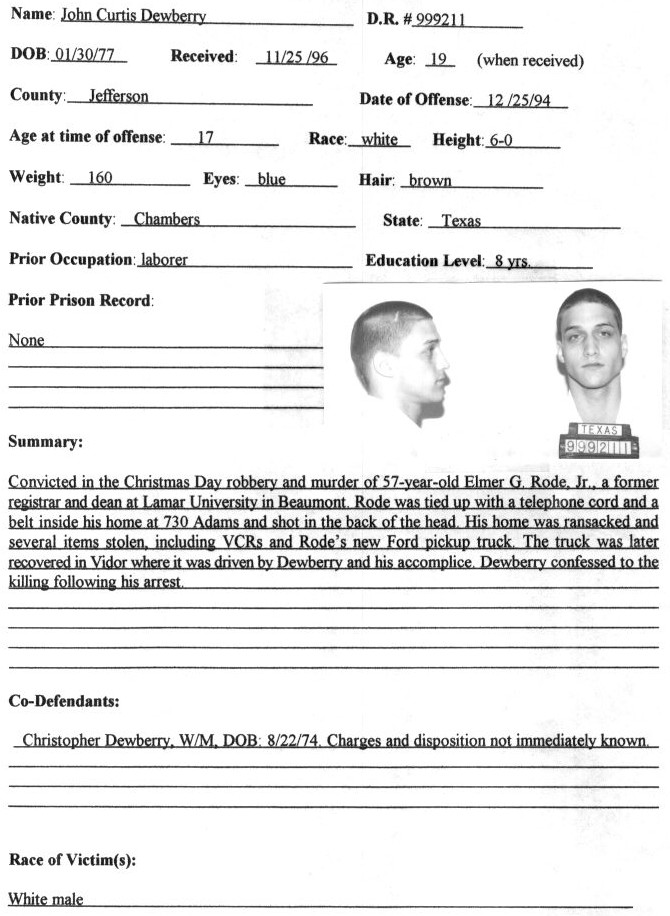|
John Curtis Dewberry v. State of
Texas Excerpt
The egregious
facts of this offense indicated appellant planned, weeks before
this offense, to carry out a murder and robbery. Joshua
Vickers testified that he sold appellant a sawed-off, 20-gauge
shotgun after Thanksgiving 1994. Appellant told Vickers he
wanted the gun for “a jack move,” which Vickers understood to mean
a hijack.
Mitchell
King, who had been staying with appellant and his brother since
August 1994, testified that a week before Christmas, appellant
asked King if he “knew about making some money.” Appellant
told King he knew a man “that had some money and [appellant] could
go and burglarize his house and take the money, get the money.”
Appellant also told King, “he knew the guy had a lot of money, had
a lot of stuff, so [they could] get some money for Christmas.”
King testified that appellant said they were “going to have to
shoot [the owner of the house to] get our money.” When King
asked why appellant wanted to kill the owner, appellant replied
“it was something personal” between him and the guy.
The
murder of Elmer Rode was brutal. His sister, Ginger Rode,
discovered Elmer’s body in his apartment on Christmas Day.
Officer Daniel Holloway of the Beaumont Police Department was
dispatched to the scene and testified he found Elmer Rode lying on
the floor in the living room. Rode’s hands were tied behind his
back with a telephone cord, and his feet were tied together with a
belt. A pillow with bullet holes was lying across his head.
After Rode’s funeral, Ginger discovered her brother’s pawn ticket
for the .22 caliber pistol while cleaning his house. The State
later proved this pistol was stolen from Rode by appellant and/or
his brother and was used to shoot Rode. The forensic pathologist
testified there were four small caliber gunshot wounds and one
contact shotgun wound to Rode’s head. The pathologist also found
evidence indicating Rode was beaten up and strangled at some
point. Abrasions on Rode’s wrists suggested Rode struggled
against his bonds before he was killed.[1]
The State
also introduced evidence showing Rode was robbed. The bedroom was
ransacked, and the bedroom door was removed from its hinges. A
VCR in an unopened box, along with another VCR, were stolen from
the residence. Rode’s pickup truck was also missing. After the
murder, Vickers went to appellant’s apartment where he saw two
VCRs - one in an unopened box. Appellant asked Vickers if he knew
anyone who wanted to buy a VCR.
Mark Bilfafano provided
evidence implicating both appellant and his brother in the murder
and robbery of Rode. Bilfafano testified that appellant,
accompanied by his brother, Chris, showed up at his house on
December 24th. Appellant wore surgical gloves and was driving
Rode’s pick-up truck. Bilfafano testified he saw two VCRs and a
handgun (which looked like a .22 caliber pistol) in the truck. He
testified appellant was in possession of a shotgun which “looked
like” the weapon that the State alleged appellant used to kill
Rode. Bilfafano accompanied appellant and Chris to leave Rode’s
truck in a shopping center parking lot in Vidor, Texas. En route,
Chris told Bilfafano “they killed somebody.” Before leaving
Vidor, appellant wiped down the truck.
Bilfafano’s testimony
indicated appellant showed no remorse for his actions after the
murder. On the way back to Beaumont, appellant threw the keys to
the pickup into the Neches River. Bilfafano also saw appellant in
possession of about $400 in cash. Appellant told Bilfafano “we
had to take care of business,” that Chris “chickened out,” and
that “they tied [Rode] up.” Appellant also informed Bilfafano
“they killed somebody and they just laughed about it.”
The
evidence at trial further showed appellant and Chris exchanged the
two VCRs and the .22 caliber pistol with Bobby Trevino for $50 and
5 or 6 stones of “crack.” Trevino, however, refused the shotgun
after Chris told him “they put a pillow over a guy and blasted him
with the [it].”
Two juvenile
probation officers, Katie Durio and Ruth Hall, also testified
during the punishment stage about their experiences with
appellant. They testified appellant’s records contained twelve
“referrals” for offenses committed by appellant while under their
supervision, including burglaries, other property crimes, and drug
offenses. Appellant was ultimately committed to the Texas Youth
Commission (“T.Y.C.”). Durio and Hall testified appellant was a
“violent” person and that he was a leader who “instigated things.”
He was “very bright until he [did not] get his way” and
“manipulative” when he lost his temper.
The
State proved appellant attempted to escape from custody while
awaiting trial. A deputy sheriff testified that while he was
transporting appellant and three other inmates back from a
dentist’s office appellant and another inmate, Keith Gulley,
escaped from the county van. While the van was stopped at a
traffic light, appellant and Gulley burst from the back door and
ran away. They were found a short time later hiding in a field
not far from where they fled from the vehicle. They had removed
their handcuffs with a key that Gulley had acquired.
While
incarcerated awaiting trial, appellant’s behavior indicated a
potential for future violent acts. Two officers, who supervised
appellant while he was incarcerated, testified during punishment.
A corrections officer testified that during a shakedown of
appellant’s single-man cell, appellant was found in possession of
razor blades and sharpened paper clips which could have been used
as or to fashion weapons. Another corrections officer testified
that appellant was belligerent towards officers, “constantly
cursing at us, making sexual references and preferences to us,
what he wanted to do to us, what he thought we should do.” That
same officer testified that, in a separate incident, he discovered
a bag in appellant’s single-man cell containing 20 whole razor
blades.
Gaye Bailey testified she
knew appellant, that appellant had a bad reputation for being a
peaceful and law-abiding citizen, and that he had a “very violent
character.” Laci Bailey Girior, a former girlfriend of appellant,
testified that when she broke up with appellant, he broke into her
house, stealing items of monetary and sentimental value.[2]
She also testified appellant carried a knife during the time they
dated. While appellant was in T.Y.C., he threatened to rape and
kill Girior when he got out. She said that appellant never
demonstrated “any kind of conscience for the things that he did
that were bad.”
Additionally, the State admitted details from the offense reports
of appellant’s escape from the van through the cross-examination
of one of appellant’s expert witnesses. The offense reports
included statements from the third and fourth inmates in the van
who both indicated appellant was a willing and active participant
in the escape.
Steve Young
also testified for the State. Young told the Court that, in his
opinion, appellant had a violent character. While dating
appellant’s mother, Young became acquainted with appellant prior
to appellant’s T.Y.C. incarceration. Young stated that he
witnessed appellant kill an armadillo with a bayonet. On another
occasion, Young saw appellant in possession of brass knuckles.
The State’s psychiatric expert testified that his review of
appellant’s history and the facts of the instant case indicated
“that [appellant] would pose a potential for danger in the
future. So I would consider him to be likely to be dangerous in
the future.”
We
conclude that appellant, in carrying out this crime, exhibited a
callous and wanton disregard for human life. A jury can
rationally infer future dangerousness from the brutality of the
offense. See Sonnier v. State, 913 S.W.2d 511, 517 (Tex. Crim.
App. 1995). Additionally, the evidence establishes that appellant
planned the capital murder of Elmer Rode, carried it out
methodically and brutally, and showed no remorse or contrition for
his actions. Future dangerousness may be supported in part by
evidence of a lack of remorse or contrition. See Rachal v. State,
917 S.W.2d 799, 806 (Tex. Crim. App. 1996), cert. denied,
__U.S.__, 117 S.Ct. 614 (1996). The brutal nature of the
murder/robbery of Rode, and appellant’s lack of contrition and
remorse, were sufficient for the jury to find appellant would be a
continuing threat to society. See Allridge v. State, 850 S.W.2d
at 488-89; Rachal, supra; Sonnier, supra. When combined with
other evidence presented during the punishment stage of
appellant’s trial, we conclude the evidence was sufficient for a
rational jury to conclude beyond a reasonable doubt that appellant
posed a future danger to society.
[1]
The pathologist
testified Rode was killed “around” December 23rd.
[2]
Appellant was
incarcerated in the Texas Youth Commission for this burglary. |


